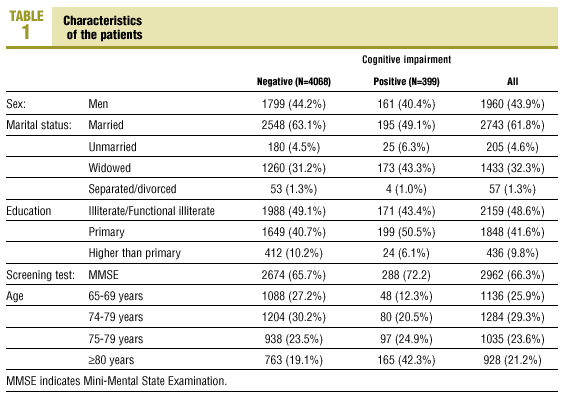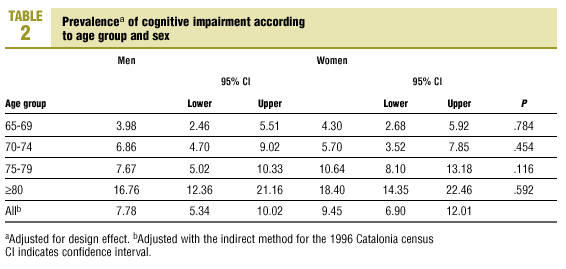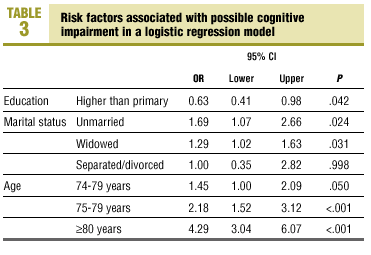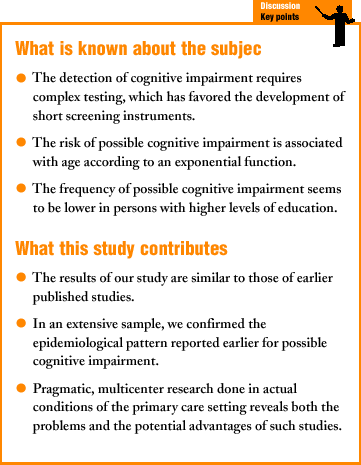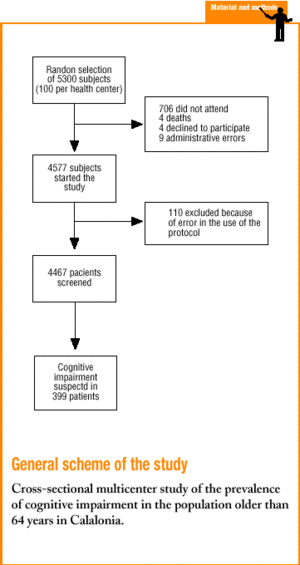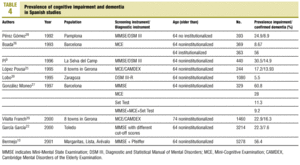Introduction
Of the health problems that most often affect the population of older people, cognitive disorders in behavior and dementia are important because of their magnitude and seriousness, as well as because of their impact on the quality of life of patients, their relatives and their care-givers. Because of the steady aging of the population, these problems, and the resources devoted to coping with them, are expected to increase.
Especially in its early stages, dementia syndrome is diagnosed with detailed neuropsychological tests of the patient´s mental state and an evaluation of his or her functional status, in an attempt to rule out reversible causes of cognitive impairment.
Because of the complexities of evaluating mental state, short screening instruments have been developed for use with patients thought to suffer from cognitive impairment. The Mini-Mental State Examination (MMSE),1 one of the most widely used tests internationally, has been translated and validated for use with Spanish-speaking persons.2 Depending on which version and cut-off score are used, sensitivity of the test can be very high (close to 100%) and specificity can reach 86%.3 For these reasons the National Institute of Neurological and Communicative Disorders and Stroke-Alzheimer´s Disease and Related Disorders Association (NINCDS-ADRDA) recommends the MMSE for use as a screening instrument to detect possible cognitive impairment in epidemiological studies.4
The aim of this study was to calculate the prevalence of patients with a positive result on a test used to detect possible cognitive impairment in a sample of persons older than 64 years who received primary care at public health system centers in Catalonia.
Population and method
This study was done as part of the Cuida´l Project5, and reports the findings obtained in the first phase of the project.
Design
This cross-sectional study was done in a random sample of persons older than 64 years who were on the list of patients served by 53 primary health care centers in Catalonia.
Inclusion and exclusion criteria
We randomly selected a total of 5300 patients (100 patients per center). Participants were recruited with phone calls (three calls at different times of the day, one on the weekend) or when they came to the center for other reasons. We excluded institutionalized patients and itinerant patients with a temporary home address (and who were expected to be at this address for less than 6 months). Participation in a home care program was not an exclusion criterion.
The number of subjects included allowed us to estimate an expected prevalence of approximately 10% in different subgroups, at a 95% level of confidence and a precision of 2%, based on a study design that stipulated selection by primary care center (design effect).6
Measurement of variables
The measurement instrument was the MMSE; for patients who indicated they could not read or write we also used Isaacs Set Test.7
Practitioners were trained in the use of these measurement instruments in sessions with standardized cases to ensure that a common set of criteria was used. The tests were given by members of the patient´s usual primary care team (physician or nurse).
Information about age, sex, highest level of education and marital status was also recorded. All data were obtained during the period from January to June, 1999.
Criteria used to determine positive results
Patients were considered to have possible cognitive impairment if their MMSE score was lower than 24. If the patient was illiterate, possible cognitive impairment was considered to exist when the Set Test score was below 27 or when the MMSE score was lower than 19.
Strategy for data analysis
Because participants were selected randomly from the patient lists of each center, the effect of this design was taken into account when we calculated the prevalence of possible cognitive impairment. We defined the variance as the sum of variances within each center.6 The resulting figure was then adjusted by the indirect method for the population of Catalonia as determined from the 1996 census.8
Bivariate analysis was done with the chi-squared test and Student´s t test or analysis of variance (ANOVA). Multivariate analysis was based on a logistic regression model with presence of cognitive impairment (code 0, no impairment; code 1, impairment) as the dependent variable and all other variables as prognostic factors. The variables age (with 60-64 years as the reference category), marital status (with married as the reference category) and level of education (with primary education or lower as the reference category) were also included.
Results
Of the 5300 patients selected, 4467 (84%) took part in the study. The reasons for nonparticipation were patient´s refusal or inability to locate the patient (710 persons), death (4 persons), or administrative error (9 persons). Of the 4577 remaining persons, a further 110 were excluded later because of errors in the use of the cognitive impairment detection protocol. Persons who did not participate did not differ significantly in age or sex from participants.
Mean age of the patients was 74.5 (6.4) years. All other characteristics are summarized in Table 1.
With the cut-off scores used for the present study, we detected 399 patients as possible cases of cognitive impairment (72.3% with the MMSE). The percentage of positive results was estimated as 7.8% (95% CI, 5.3%-10.0%) in men and 9.5% (95% CI, 6.9%-12.0%) in women, after adjustment with the indirect method for the 1996 Catalonia census. Table 2 shows the results according to age group and sex.
The results of the multivariate analysis are given in Table 3. The risk of possible cognitive impairment increased with age, and was fourfold as high in the group of participants aged 80 years or older in comparison to the 60-64-year-old group. Persons who had been educated past the primary school level had a lower risk (OR, 0.63; 95% CI, 0.41%-0.98%). For unmarried and widowed persons the odds ratio was greater than 1, which was a statistically significant result for both variables.
Discussion
The prevalence of possible cognitive impairment in our population of persons older than 64 years was 9.5% in women and 7.8% in men. The epidemiological pattern was similar to that seen in other studies of the prevalence of dementia in other populations in our setting.9,10 The prevalence increased with age, a finding that was not affected by adjustment for age, marital status or educational level. Jorm et al11 analyzed this finding and concluded that the prevalence of moderate to severe dementia doubled every 5 years, approximately, according to an exponential model. A systematic review12 and another Spanish study13 showed that this tendency toward an exponential increase weakened after the age of 85 years, and it has thus been suggested that a logistic model would best explain the relationship between the frequency of cognitive impairment and age. According to this model the prevalence of dementia should level off at 40% at the age of 95 years.
Some studies have found a greater prevalence of cognitive impairment in women, which might be explained by the greater incidence of dementia, which is relatively independent of age before 80 years,14 and by the lower mortality in women.15 However, in our sample the difference between sexes was not statistically significant in any age group.
The role of educational level in the risk of developing dementia is controversial. In the present study possible cognitive impairment was less frequent in persons with schooling past the primary level, compared to the rest of the participants, after adjustment for age, sex and marital status. This finding is consistent with other studies, which found that higher levels of education were associated with lower probabilities of dementia at old age, especially in women.16 Several different biological mechanisms may that account for this association,17 but noteworthy among them is the fact that higher educational level and socioeconomic level are related with lower frequencies of cerebral vascular disease.18 In fact, most patients with dementia have a combination of vascular and Alzheimer-like diseases.19 It is assumed that persons with more years of education and a higher socioeconomic level have a healthier lifestyle and receive more and better medical care,8 and that their brains will acquire fewer lesions, especially in the small vessels where they contribute to the appearance of dementia.19 However, other autopsy-based20 and epidemiological studies21,22 have failed to find any relationship between level of education and the frequency of dementia.
Some epidemiological studies have also found that unmarried persons, in comparison to married persons, have a greater risk of dementia or Alzheimer´s disease.23 It remains to be established whether this association is spurious or whether it has a plausible explanation. In this connection, another study found that dementia is less frequent in older persons with an active social life with their family and friends (even if they live alone) than in persons who live alone but who have no close social or family ties.24 It should be recalled that personality traits and especially moods such as depression are confounders in scoring psychometric tests, and we could not control for such factors (depressed patients respond worse in the test). In addition, any initial phase of dementia involves a component of reactive depression, making it uncertain whether what the test really measures is actual cognitive impairment or depression.
Comparison with other studies
The epidemiological data published to date9,10,22,25-30 are variable regarding the prevalence of cognitive impairment and dementia in our population, with estimates ranging from 8.7 to 56.4%. The large range of figures is due to important methodological differences in the screening instruments used in different studies, in the age of the population, and in the inclusion or exclusion of institutionalized patients.22 Table 4 summarizes the main findings in these studies.
Limitations of the study
Although it was not a major aim of the Cuida´l Project, the first phase of the study detected possible cases of cognitive impairment that will later need to be verified with detailed neuropsychological examination. However, no patient with a cut-off score on the screening tests above the figure we used to identify possible cases of cognitive impairment was referred for further testing. As a result, the exact likelihood ratio for dementia in our study population cannot be determined.
The range of scores on the MMSE is influenced by the level of education, and is higher for subjects with higher levels of education. If a single cut-off score is used, the number of false negatives among persons with more years of schooling increases, as does the number of false positives among persons with fewer years of schooling. In the present study this effect was offset in part by using two instruments (one specifically for illiterate patients) and two different cut-off scores for the MMSE.
A further limitation might be the large number of researchers involved, and hence interobserver variability, although we tried to reduce this to a minimum with previous training in the administration of the MMSE and the Set Test.
Future lines of research
A number of questions regarding the detection and diagnosis of cognitive impairment remain unanswered: the tests we used are sensitive, but the results we obtained are closely linked to age and educational level. Moreover, because these tests are not designed to diagnose dementia, they cannot take the place of more extensive neuropsychological studies for persons suspected of suffering cognitive impairment. In addition, more reliable tests are needed for the illiterate population; analysis of the agreement between the results of the Set Test and the MMSE might well shed light on this issue.
1Cuida´l Project researchers
ABS Badalona 4 (J. Forcada, A. Llibre, E. Borlan, M. Llorens, A. Martínez); ABS Badalona 5 (I. Oliva, M.M. Domingo, S. Mas, ML. García, C. Palazuelo, C. Piñol, M. Puche, J. Llussà, S. Zamora); ABS Badalona 6 (C. Seco, A. Díaz, J. Fariña, V. Roger, N. Puig, P. Escobedo, A. Robles, A. Girona, M.J. Toribio, P. Laporta, C. Batlle, T. Rama, F. García-Faria, M. Brugada, I. López, R. Cabello, E. Galindo, C. Torán, M.J. Ulldemolins, C. Albaladejo, E. Gejo, A. Martín, M. Castaño, P. Beato, S. Mateu, G. Pizarro); ABS Badalona 7 La Salut (J. Milozzi, M. Ruiz, J. Teruel, M. Giné, I. Barrio, J. Comín, M. Murt, M. Sánchez, A. Muñoz, A. Utgés, S. Gutiérrez); ABS Badia Del Vallès (C. Yuste, P. Torres, M. Montasell, R. Azagra, M. Fuentes, J.F. Doz, Q. Figueras, L. Mengual, C. Lluma, G. Gasulla, L. Mayordomo, P. Roura, E. Gutiérrez, M. Iglesias, M. Ruiz, J.M. Bonet, D. García, F. Solé, F. Tarrago, J. Llonch, M. Pons); ABS Raval Sud (D. García, M.V. Pitarch, P. Escobar, L. Ibáñez, M. Ferran, J. Casas, B. Casabella, R. Ruiz, J. Pertiñez, A. Hervàs, M. Sánchez, M. Canet); ABS Trinitat Nova (N. Castells, C. Munar, M. Estruch, J. Ametlla, A. Roig, X. Flor, C. González, M. Mas, L. Sánchez, J. Guerrero, A. Buendia, M. Delgado, M.J. Pujol, J. Garbayo, D. Pérez, R. Melió, M.M. Fraga, N. Castells); ABS Barcelona 9-D (M. Godall, J.M. Carpio, A. Moretó, A. Díez, A. Rosas, E. González, M.C. Mateu); ABS Barcelona 9-E (Ll. Llosà, D. Granés, R. Espona, M.C. del Olmo, A. Cano, A. López, A. Alario, F. López, F. Mateos, M.C. García, J.J. Rodríguez, M. Mayorga, S. Martínez, N. Matilla); ABS Barcelona 9-F (J. Juvanteny, I. Angulo, I. Feijoo, I. Giner, A. Broto, J. Galindo, G. Planas, M. Barrachina, A. Aymar, N. Aramendía, M.A. Fuertes); ABS Barcelona 9-G (M. Roura, C. Font, T. Cervelló, C. Ramon, X. Corpas, V. Miralles, E. Olivé, J.L. Losada); ABS Besalú (C. Pou, I. Fernández, C. Pérez, R. Guixà, P. Zacarías, E. Bayona); ABS Capellades (A. Brugués, P. de Millan, P. Salat, J. Martí, I. Colomer, A. Garriga, X. Solé, M. Garriga); ABS Castelldefels (M. González, C. Moliner, J.C. Contel, P. Reig, J. Gené, A. Baulies, J. Gil); ABS Cornellà La Gavarra (J. Martorell, C. Padin, F. Borrell, R. López, S. Espluga, E. Florensa, O. Moreno, C. Bayona, C. Martí, A.M. Aceituno); ABS Cornellà 2 (E. Sánchez, M. Lacoste, I. Montaner, O. Ortiz, A. Jurado, M.E. Galan, J. Pacet, M.I. Martín, C. Busquier); ABS Cornellà 4 (J. Toll, M. Rodríguez, M. Server, H. Pi, P. Barreto, M. Porta, V. López, L. Ribas, L. Pérez, C. Muñoz); ABS El Prat 3 (C. Batalla, T. Graell, A. Ezpeleta, F. González, E. Comín, M. Miñano, E. López, A. Alfonso, A. Cuenca, O. Mazeres, J. Riba); ABS Esplugues 1 (T. Julia, I. Porta, C. Mateo, C. Romero, M. Varona, I. Monte, T. Cabases, F. Alguacil, P. Monge, J. Rodríguez, P. Forgas, M.J. Cerain, M. Cardona); ABS Esplugues (A. Serra, C. Torró, A. Morales, M. Llagostera, P. Wemberg, M. Arriola, D. Marginet, P. Pérez, D. Tornos, J. Ventura, C. Truque, E. Bleda); ABS Garraf-Rural (A. Pérez, J.M. Benet, J.C. Caballero, P. Sabaté, J. Hernández, E. Cuesta, P. Torrecilla, B. Federio, J.R. García, P. Foz, M. Duran, R. Sáez, R. Cañizares, X. Castro); ABS Gavà 2 (C. Almirall, A.M. Oliveira, E. Caramés, C. Galera, I. García, T. Vintró, A. Espín, L. Gonzalo, M. Soler, D. Benítez, E. Linares); ABS Girona-1 (C. Bou, M. Clot, C. Serra, M.A. Agüero, C. Sais, M. Salvans, A. Massaguer, M.C. Asensio, S. García, J.M. García, P. López, F. Carulla, P. Rigall, M. Collantes, E. Calvet, N. de Puig, M.A. Agüero, J. Portas, R. Sánchez, M.R. Carbó, M.A. Hereu, M. Martínez); ABS Igualada-Urbà (M. Ortinez, C. Espinós, D. Basas, C. Riera, M. Vilarrubias, T. Higuera, J. Zambudio, N. Solà, P. Fusté, C. Castelló, R. Chinarro, M. Canals); ABS L´Hospitalet-Centre (A. Ribas, R. Carrasco, M. Boada, J. Solé, R. Canal, D. Pérez, C. Morató, F.J. Millet, A. Traite, M.J. Megido, S. Milian, S. Copetti, V. Sahonero, E. Juncadella, N. Maymó, J.M. Fandos, M. García, N. Fernández, M. Martos, E. Rodero, C. Mateos, E. Serra, M. Murcia, T. Rubio); ABS L´Hospitalet-Gornal (M. Hernández, A. Siurana, X. Alba, C. Santiago, G. Fanlo, C. Cortina, J. Mercader, C. Blanco, F. Benavente); ABS L´Hospitalet-Sant Josep (C. Lafuente, A.M. Lafuente, S. Alia, J. Vilaseca, P. Garcés, M.A. Méndez, L. Sandé, A. Fuentesauco, A.M. Gil, V. Cabré, M. Bielsa, A. Gaitano, J. Mena, A.M. de las Mestas, M. Rico); ABS L´Hospitalet-Sta. Eulàlia (N. Borrell, C. Añaños, I. Sánchez, T. Meix, A. Evangelio, F. Torralba, S. Berlanga, A. Sanz, X. Mas, M.M. Forés, R. Viñas, J.A. Hernández, I. Zamora, D. Riera, M.L. Tarrida); ABS L´Hospitalet-Pubilla Cases (A. Planas, J.M. Veciana, E. Gavilán, F. Rodríguez, I. Vega, R. Tosquella, M. López, A. López, G. Sánchez, L. Velázquez, L. Velázquez, F. Segril, M. Martín); ABS La Jonquera (P. Pujol, C. Ruiz, Y. Massó, L. Boix, A. López, D. Pérez, J. Domènech, M. Bonet, M. Forès, X. Lecumberri, J. Isard, M. Pous, J.L. Yecora); ABS Lleida 4 (R. Sánchez, X. Alcalde, P. Navarro, E. Domínguez, Ll. Marco, M. Martínez, P. Santafe, T. Oliver, D. Ferrer); ABS Manlleu (E. Castell, A. Costa, J. Fontarnau, J. Sierra, J. Deniel, E. Casellas, M. Vilamú, A. García, S. Suriñach, A. Llagostera, V. Canal, D. Casadesús, C. Olmedo); ABS Martorell (Ll. Esteve, F. López, F. García, T. Badia, F. de Cabo, J. Peligro, C. Herráez, T. Alonso, C. Baiget, A. Oliete, L. Pérez, M. Fuentes, I. Vergès, E. Pérez, M. Moreno, L. Oliveras, M. Canals, C. Rovira, C. Luna); ABS Penedès-Rural (A. Cererols, J. Llach, J. Flórez, M. Elías, P. Piñeiro, M. Costa, R. Manuel); ABS Piera (J. Solanellas, R. Torremorell, H. Cortés, J.D. Guevara, S. Caballero, R. Ribas, S. Marcelo, N. Carré, A. Lloses); ABS Roses (F. García, T. Bosch, P. Morcillo, P. Viedma); ABS Sant Adrià 1 (C. Ferré, C. Valladares, A. Plaza, C. Roser, M. Portes, E. Dura, M.J. Lorente, M. Lladó, R. Caro, M.A. Rocabayera, Ll. Vilalta); ABS Sils-Vidreres-Maçanet (A. Teixidor, M.C. Fondon, C. Pons, A. Sanchís, M. Boldú); ABS La Mina (R. Ciurana, L. Alejandro, C. Espel, M. Vilà, M. Mata, I. Bobé, J. Davins, A. Sáez, M. de la Figuera, A. Salvadó, C. Pareja, F. Soriano, E. Vinyoles, C. Royo, J.M. Mendive, E. Zabaleta, C. de Juan, M. Castillo, R. Centelles, J. Rengel, S. Calvet, J. Agudo, A. Ramos, M. Canals); ABS St. Boi de Llobregat 2 (M. Muñoz, A. Rourera, C. Alvarado, A. Fernández, C. Espelt, MJ. Gracia, M. Via, M. Dordal, E. Steiner, R. Rodrigo, J. Alegre, E. Conesa); ABS St. Boi de Llobregat 3 (C. Tamayo, S. González, A. Espinola, T. Arnau, A.R. Hernández, R.M. Marcos, A. Val, R. Giner, C. Barrio, C. Rubio, F. de la Torre, C. Gorrindo, I. Vázquez, M.R. García); ABS St. Feliu de Guíxols (R. Herrero, T. Planas, P. Carreras, J. Rovira, L. Cinos, M. Muñoz, D. Torres, C. Xargay, C. Comas, M.A. Oliveras, J. Lafont, M. Félez); ABS St. Just Desvern (J. Muniesa, N. Aresté, X. Serra, R. Rabaneda, Ll. Morató, D. Ruenz, A. Wilke, L. Crespo, F. Ridao, S. Granollers, C. Marcos); ABS Sta. Coloma de G. 1 (T. Morató, A. Muñoz, M.M. Ansaldo, M. Tramuns, I. López, M. Fuentes, J. Vidal, A. Vidal, M. Roset, E. Sabaté, M.J. Polo, A. Vilanova, A. Sancho, E. Corral, A. Taboada, T. Sala, P. Rodríguez, D. Molina, E. Martínez); ABS Sta. Coloma de G. 4 (R. de León, C. García, R. Forés, A. Gallart, C. Vela, R. Escolar, M. Alzamora, A. Fuentes, B. López, M. Puente, R. González, R. Ferrero, M. Sorribes, F. Margarit, M. Monsó); ABS Sta. Coloma de G. 6 (M.J. Martínez, J. Hernández, M. Pozo, O. Martínez, C. Lisicic, C. Aguilera, X. Dauder, M.M. Isnard, D. Olmos); ABS Sta. Eugènia de Berga (A. Ribas, J. Verdera, A. Planes, J. Oliva, C. Blay, M. Molas, R.M. Salla, D. Rovira, A. Puente, H. Algilaga, T. Iruela, L. Vila, J. Espinàs, E. Caballé, E. García); ABS Tarragona-1 (N. Sarrà, M. Fortín, M. Pollcarpo, M. Henrich, P. Camós, M. Romera, J.M. Roca, J. Monteverde, R. Tigell, M. Juncosa); ABS Tarragona-2 (N. Saun, C.M. Fuentes, B. Rull, E. Satué, R. Canals, M. Barrera, E. Valdivieso, A. Veiga); ABS Terrassa C-Can Parellada (A. Sánchez, R. Camps, A. Casasayas, A. Navarro, O. Grima, M. Nozal); ABS Tortosa Est (J.I. Viloria, J. Clua, M.J. Arasa, J.F. Monclús, J.M. Basart, F. Vallespí, G. García, E. Ciurana, A. Casanova, T. Rupérez, E. Ibáñez, C. Mangrané, E. Gómez, R. Arasa, S. Ponce, N. Beguer, X. Bautista); ABS Vallirana (J. Creixell, E. Castro, C. Càmara, P. Miret, A. Izquierdo, J. Merin, J.M. Olmo, M. Sabaté, R. Llaurador, C. Pujol, A. Balibrea, C. Pérez, N. Casamada, S. González, J. Mata, S. San, V. Bardají); ABS Viladecans 2 (D. del Pino, P. Simonet, A. Padilla, A. Viniegra, E. Rillo, R. Villafafila, C. Lecumberri, C. Verduras, M.A. Fernández, C. Bentue, M.V. Vico, D. Ruiz, P. Figuera, A. García, D. Mora); ABS Vilafranca Urbana (M.L. Gardeñes, M. Ballester, D. Ferrer, P. Utrilla, R. Manuel, B. Coscollar, R. Rodrigo, R. Marchan, M. Giralt, M. Carrascosa, A. Robledo, J.A. Domínguez, B.M. Dinares); ABS Vilanova 1 (I. Garro, C. Casamayor, M. Navarro, O. Fuster, M. Briva, C. Batet, G. Mendoza, Ll. Gimeno, P. García, M.A. March).
Correspondence: Esther Limón Ramírez. ABS Sant Miquel. Francesc Macià, 154. 08400 Granollers (Barcelona), Spain. E-mail 30705elr@comb.es
This study was partially financed by the TV3 Fundació Marató (1019/97), and a shorter version of this report was presented at the Congress of the Spanish Society of Family and Community Medicine (semFYC), Gijón (Spain), November 2000.
Manuscript received 1 August 2002.
Manuscript accepted for publication 18 December 2002.








